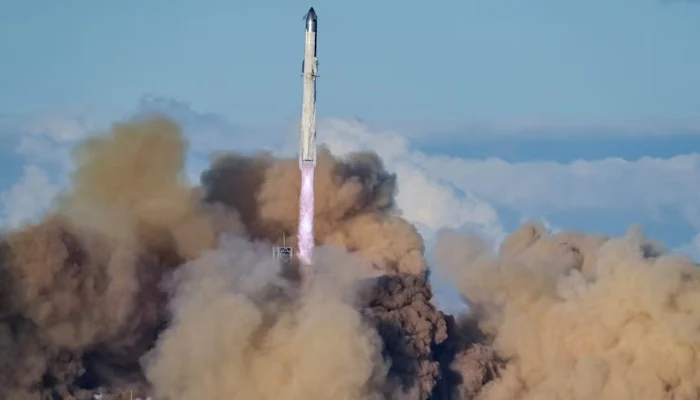Select Language:
SpaceX successfully launched its 11th Starship rocket from Texas on Monday, followed by a water landing in the Indian Ocean. This mission marks the last test flight before the company begins testing a new, more advanced version of the massive rocket designed for lunar and Mars missions.
The Starship, comprising the upper stage stacked on the Super Heavy booster, took off at 6:23 pm CT (2323 GMT) from SpaceX’s facilities in Starbase. After launching, the Super Heavy booster made a controlled water landing in the Gulf of Mexico about seven minutes later, testing a specific landing engine configuration before self-destructing.
This flight was similar to the previous one in August, which broke a streak of failures earlier this year. It involved deploying a set of mock Starlink satellites, briefly reigniting its engines in space, and testing new heat shield tiles during its fiery descent back to Earth before splashing down west of Australia.
Nasa Acting Administrator Sean Duffy shared on X that the mission was “another major step toward landing Americans on the Moon’s south pole.”
Looking ahead, SpaceX plans to test a more sophisticated Starship model equipped with crucial upgrades needed for sustained space missions. These upgrades include docking adapters and hardware for orbital refueling—a complex process where two Starships dock in orbit to transfer thousands of tons of super-cooled fuel.
SpaceX President Gwynne Shotwell highlighted the significance of this upgraded prototype, stating, “This is the vehicle capable of taking humans to the Moon and Mars. That’s the one we aim to perfect.” She anticipates that this version could fly by the end of the year or early next year. Elon Musk, SpaceX’s CEO, has mentioned plans for a refueling mission involving two Starships next year, aligning with Nasa’s expectations to achieve this milestone in 2024.
Refueling is one of many critical tests ahead of the rocket’s human lunar landing planned for 2027. The strategy involves multiple tanker launches to fill a single Starship with enough fuel to land on the Moon.
This effort is part of a more than $3 billion contract SpaceX secured in 2021 through Nasa’s Artemis program—the U.S. initiative aiming to land astronauts on the Moon for the first time since 1972. The project places SpaceX in a space race with China, which intends to land humans on the Moon by 2030.
Nasa safety advisors recently warned that slow progress on developing components of the lunar lander could delay the U.S. moon mission by several years. Achieving a test landing on the Moon’s rugged surface remains a top priority for SpaceX.
Starship, the most powerful rocket ever built and significantly larger than SpaceX’s Falcon 9, is also central to deploying heavier Starlink satellites—crucial for the company’s expanding mobile broadband ambitions—and ultimately supports Musk’s vision of humans and cargo reaching Mars.






